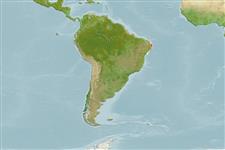Classification / Names
ชื่อสามัญ | ชื่อพ้อง | Catalog of Fishes(สกุล, ชนิด) | ITIS | CoL | WoRMS | Cloffa
sub class Elasmobranchii (ฉลามและกระเบน) (sharks and rays) >
Myliobatiformes (Stingrays) >
Dasyatidae (Stingrays) > Dasyatinae
Etymology: marianae: Named for Mariana R. Oliveria, daughter of Otto B.F. Gadig..
Environment: milieu / climate zone / depth range / distribution range
นิเวศวิทยา
เกี่ยวกับทะเล,น้ำเค็ม สัตว์น้ำหน้าดิน; ระดับความลึก 2 - 15 m (Ref. 36974). Tropical; 0°S - 19°S, 38°W - 45°W (Ref. 36974)
Southwest Atlantic: along the northeastern Brazilian coast, from the state of Maranhão to southern Bahia.
ขนาด / น้ำหนัก / Age
Maturity: Lm ? range ? - ? cm
Max length : 40.0 cm WD เพศผู้/กระเทย; (Ref. 36974)
Short description
สัณฐานวิทยา | ความยาวต่างๆ
This medium-sized species of Dasyatis is distinguished by the following characters: horizontal diameter of eye nearly equal to interorbital width and spiracle length; its tail is relatively short, less than two times disk width, distally filiform, with dorsal and ventral finfolds, ending approximately on same vertical line; height of dorsal finfold 1.5-2 in height of ventral finfold; the dorsal surface of disc is yellowish brown, with dark blotch between spiracles and two pairs of dark scapular and precaudal blotches; margins of disc and pelvic fins are blue dorsally; the ventral surface of disc white, with two symmetrical pairs of dark markings in adults (Ref. 36974).
Apparently associated with coral or sandstone reefs of the northeastern Brazilian continental shelf. Two female specimens were collected from the stomach of Rachycentron canadum (Ref. 36974). Juveniles also occurred in sandy beaches and estuaries. Ovoviviparous (Ref. 50449).
Life cycle and mating behavior
วัยเจริญพันธุ์ | การสืบพันธุ์ | การวางไข่ | เซลสืบพันธ์ของเพศเมีย(ไข่) | ความดกของไข่ | ตัวอ่อน
Exhibit ovoviparity (aplacental viviparity), with embryos feeding initially on yolk, then receiving additional nourishment from the mother by indirect absorption of uterine fluid enriched with mucus, fat or protein through specialised structures (Ref. 50449). Distinct pairing with embrace (Ref. 205). A gravid female aborted one fully formed embryo (Ref. 36974).
Gomes, U.L., R.S. Rosa and O.B.F. Gadig, 2000. Dasyatis marianae sp. n.: a new species of stingray (Chondrichthyes: Dasyatidae) from the southwestern Atlantic. Copeia 2000(2):510-515. (Ref. 36974)
IUCN Red List Status (Ref. 130435)
Threat to humans
Harmless
Human uses
ข้อมูลเพิ่มเติม
อ้างอิงการเพาะเลี้ยงสัตว์น้ำประวัติการเพาะเลี้ยงสัตว์น้ำสายพันธุ์พันธุศาสตร์ElectrophoresesอัตราพันธุกรรมโรคการแปรรูปNutrientsMass conversion
ผู้ร่วมมือรูปภาพหลายรูปStamps, Coins Misc.เสียงปลามีพิษ เช่น ปลาปักเป้าความเร็วรูปแบบการว่ายน้ำพื้นที่เหงือกOtolithsสมองวิสัยทัศน์
เครื่องมือ
Special reports
Download XML
แหล่งที่มาจากอินเตอร์เน็ต
Estimates based on models
Preferred temperature (Ref.
123201): 27 - 27.9, mean 27.4 °C (based on 44 cells).
Phylogenetic diversity index (Ref.
82804): PD
50 = 0.5039 [Uniqueness, from 0.5 = low to 2.0 = high].
Bayesian length-weight: a=0.01175 (0.00715 - 0.01930), b=3.10 (2.96 - 3.24), in cm total length, based on LWR estimates for this species & (Sub)family-body (Ref.
93245).
ระดับชั้นอาหาร (Ref.
69278): 3.5 ±0.5 se; based on size and trophs of closest relatives
ความสามารถในการกลับคืนสู่ปกติ (Ref.
120179): ต่ำมาก, เวลาต่ำสุดที่จะทำให้ประชากรเพิ่มขึ้นเป็น 2 เท่าใช้เวลามากกว่า 14 ปี (Fec=2).
Fishing Vulnerability (Ref.
59153): Very high vulnerability (90 of 100).
